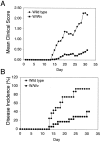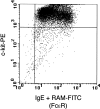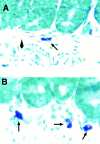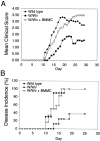Mast cells are essential for early onset and severe disease in a murine model of multiple sclerosis
- PMID: 10704463
- PMCID: PMC2195850
- DOI: 10.1084/jem.191.5.813
Mast cells are essential for early onset and severe disease in a murine model of multiple sclerosis
Abstract
In addition to their well characterized role in allergic inflammation, recent data confirm that mast cells play a more extensive role in a variety of immune responses. However, their contribution to autoimmune and neurologic disease processes has not been investigated. Experimental allergic encephalomyelitis (EAE) and its human disease counterpart, multiple sclerosis, are considered to be CD4(+) T cell-mediated autoimmune diseases affecting the central nervous system. Several lines of indirect evidence suggest that mast cells could also play a role in the pathogenesis of both the human and murine disease. Using a myelin oligodendrocyte glycoprotein (MOG)-induced model of acute EAE, we show that mast cell-deficient W/W(v) mice exhibit significantly reduced disease incidence, delayed disease onset, and decreased mean clinical scores when compared with their wild-type congenic littermates. No differences were observed in MOG-specific T and B cell responses between the two groups, indicating that a global T or B cell defect is not present in W/W(v) animals. Reconstitution of the mast cell population in W/W(v) mice restores induction of early and severe disease to wild-type levels, suggesting that mast cells are critical for the full manifestation of disease. These data provide a new mechanism for immune destruction in EAE and indicate that mast cells play a broader role in neurologic inflammation.
Figures






References
-
- Steinman L. Multiple sclerosisa coordinated immunological attack against myelin in the central nervous system. Cell. 1996;85:299–302. - PubMed
-
- French-Constant C. Pathogenesis of multiple sclerosis. Lancet. 1994;343:271–275. - PubMed
-
- Kermode A.G. Breakdown of the blood-brain barrier precedes symptoms and other MRI signs of new lesions in multiple sclerosis. Brain. 1990;113:1477–1489. - PubMed
-
- Johnson D., Yasui D., Seeldrayers P. An analysis of mast cell frequency in the rodent nervous systemnumbers vary between different strains and can be reconstituted in mast cell-deficient mice. J. Neuropathol. Exp. Neurol. 1991;50:227–234. - PubMed
-
- Orr E.L. Presence and distribution of nervous system-associated mast cells that may modulate experimental autoimmune encephalomyelitis. Ann. NY Acad. Sci. 1988;540:723–726. - PubMed
Publication types
MeSH terms
Substances
LinkOut - more resources
Full Text Sources
Other Literature Sources
Medical
Molecular Biology Databases
Research Materials

